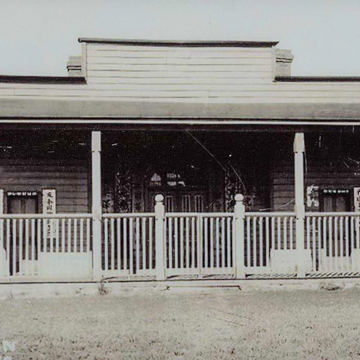Evanston was established as a railroad town when the Union Pacific Railroad was constructed through southwestern Wyoming in 1868. When the railroad was completed the following year, the company hired Chinese immigrant laborers to work on railroad section crews and in the nearby Union Pacific coal mines. Evanston was home to a substantial Chinese population from the early 1870s through the 1890s. The census of 1880 listed more than 100 Chinese residents in a town of 1,200.
In 1874, the community built a temple in the neighborhood known as Chinatown, a segregated enclave across the tracks from the main part of town. The building was a single-story, single-room, unpainted wooden structure, with a front door flanked by two windows and a shallow front porch stretching the width of the facade. Since the only visual evidence for the building comes from historic photos, its dimensions are unknown.
The building was known by Euro-American residents as the Joss House, the term "joss" referring generically to the presumptive Chinese deity and also to the incense sticks burned in religious rituals. The Joss House served not just as a temple, but also as a hostel for Chinese visitors passing through town on the railroad. On one occasion, for instance, the Joss House hosted a Chinese envoy traveling between Washington, D.C. and the West Coast.
Though some believe the Joss House was one of only three in the United States (the others reputedly in New York and San Francisco), in fact, Chinese immigrants constructed many such temples in the small mining, logging, and railroad towns of the American West where they lived and worked. A few of the original structures are still extant, including those in Marysville and Weaverville in California and one in Lewiston, Idaho.
It is likely that the Chinese residents of Evanston practiced an eclectic mix of Confucianism, Taoism, and Indigenous folk religions. There was no priest or religious leader, but one resident of Chinatown was selected each year as the “Keeper of the Joss House.” His responsibilities were to keep the building in order and stocked with whatever supplies were needed. A rare interior photograph of the building shows an elaborately carved altarpiece along with costly brass furnishings and embroidered hangings.
In 1898, two 8-foot-tall carved wooden panels were installed on the front of the building, flanking the front door. The panels were inscribed with the names of those who had donated money for their creation and installation, along with traditional Chinese symbols for good fortune and prosperity. The panels were fabricated in San Francisco from fragrant Port Orford cedar, which grows only in coastal areas of northern California and southern Oregon.
After the notorious Chinese massacre in Rock Springs in 1885, coupled with national exclusionary legislation, the Chinese population in Evanston steeply declined; by 1920, there were fewer than a dozen residents remaining in Chinatown. In January 1922, the Union Pacific Railroad, which owned the land where Chinatown had been built, forced the Chinese to vacate the Joss House. Shortly afterward, the building burned to the ground. There may have been some prior quiet intimations of the fire, because several residents of Evanston managed to salvage some of its furnishings, including the carved panels from the front of the building, before the fire broke out.
Sixty-eight years later, in 1990, Wyoming celebrated its centennial with community-based “Lasting Legacy” projects, with Evanston choosing to build a replica of the Joss House in Depot Square, the downtown civic plaza. The replica, which was based on historic photos of the original, is a 35 x 35-foot, single-story, stained wood structure. Like the original building, windows flank its front door and a shallow front porch runs the length of the facade.
The new Joss House was built to serve as a museum telling the story of the Chinese in southwestern Wyoming, and Evanston in particular. Its most treasured artifacts are the carved wooden panels that were rescued from the original Joss House, and later donated to the Wyoming State Museum. The panels were eventually given to the City of Evanston and are displayed inside the building. Also on display are a model of Evanston’s Chinatown, based on Sanborn Fire Insurance maps from 1910, and a small collection of artifacts, including a few items salvaged from the 1922 fire and others from a Chinatown archaeological excavation in the 1990s. The museum collection also includes a carved decorative panel from the interior of the building, and a wooden sign from the original structure that names the building “the East Road Dwelling Place”—which hints at its role as a hotel on the railroad, known to the Chinese immigrants as the “east road” because it led east from their landing point in California.
Although the Chinese Joss House Museum is in a different location than its predecessor, its distinctive architectural features bear witness to the nineteenth-century Chinese immigrants in the community. The Joss House is operated by the Uinta County Museum (1020 Front Street). Inquire at the museum for access.
References
Westfall, Donald, ed. Gone to Gold Mountain. Evanston, WY: Evanston Renewal Agency, 2010.

















